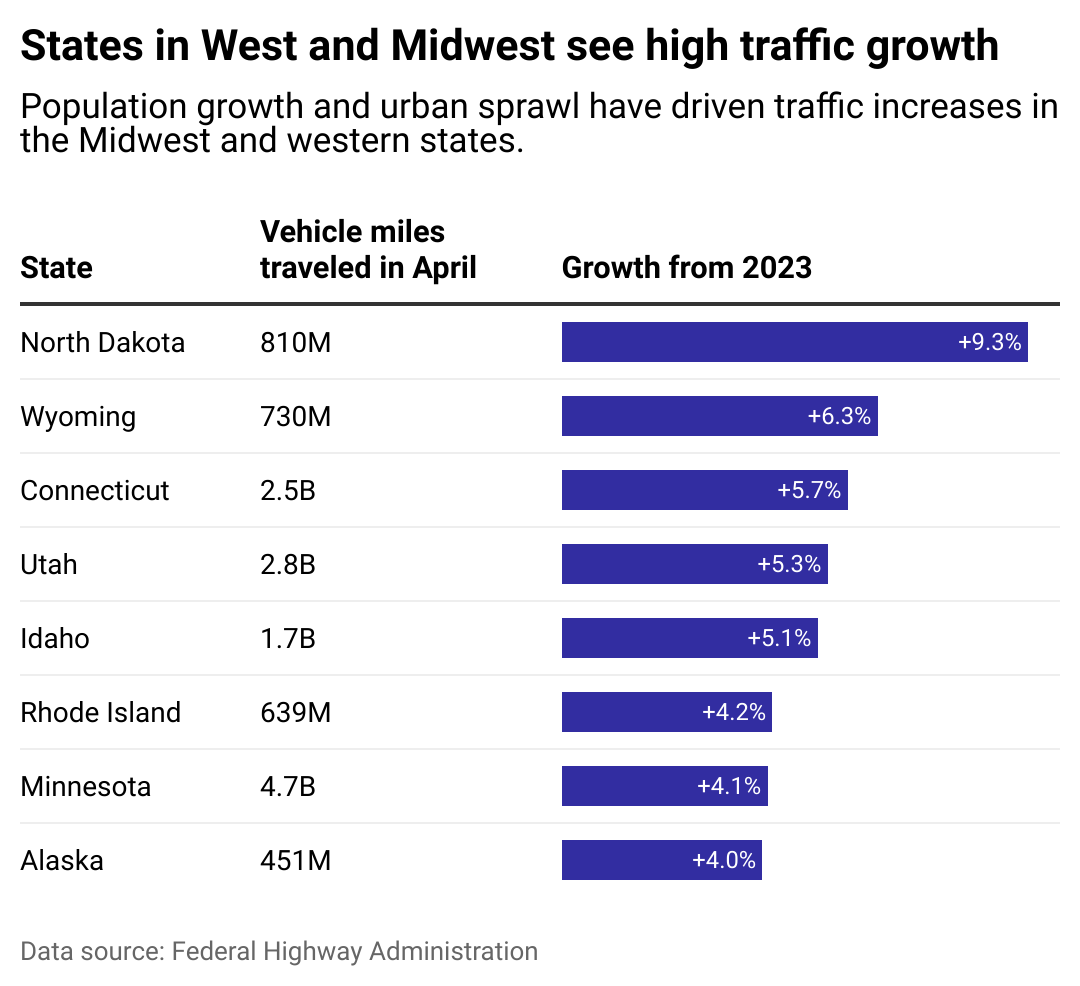Few daily frustrations are as annoying, expensive, and sometimes downright dangerous as vehicular traffic. And it's only getting worse.
Migration, population increases, development, and urban sprawl have increased traffic volume in nearly every state. In many areas, public transportation is underfunded or nonexistent, leaving residents reliant on vehicular travel. Transportation infrastructure has not kept up with population demands, with only 44% of bridges being considered in good condition, while 32% of urban roads were found to be in unsatisfactory condition. The combination of worsening congestion and weakening infrastructure is a major problem on roads and highways already straining to support current traffic volumes.
Truck Parking Club analyzed data from the Federal Highway Administration by approximately 5,000 FHWA traffic monitoring stations and determined where the country's greatest increases have occurred.
The data reflects the period between April 2023 and April 2024 and considers traffic volume increases by individual states and geographic regions.

Despite a major dip in traffic during the COVID-19 pandemic, there's been a near-universal uptick in traffic in recent years. Between 2000 and 2022, lockdowns and remote work limited the number of drivers on the roads. But by 2023, traffic began to rebound. With the lone exception of Montana, all U.S. states reported traffic increases in 2023. According to FHWA data, drivers clocked a record 3.263 trillion miles in 2023, a nationwide increase of 67.5 billion miles, or just over 2% from the year prior.
With migration driven by the rising cost of living, metropolitan development, and the return to onsite work, traffic shows no signs of slowing down in 2024.
Regional variations in traffic patterns also point to population shifts. Major increases in traffic volume occurred in the Midwest, particularly the north-central region, with a 2.7% increase for the entire region. North Dakota and neighboring Minnesota rank in the top 10 states for increased traffic volume, along with nearby Wyoming and Idaho in the Mountain West subregion. The northeast also saw a heavy increase in traffic volumes. While the region is home to many of the worst-rated traffic cities—including New York City, Philadelphia, and Boston, according to INRIX's 2023 Global Traffic Scorecard report—the biggest increases occurred in surrounding states like Connecticut and Rhode Island.
North Dakota saw the sharpest increase, with a nearly 10% rise in statewide traffic volume. Due to a booming energy sector and comparatively low costs of living, over 100,000 people flocked to the state over the last decade, until the state declared a record population count in 2023.
While this is not the largest population increase among all states, many of the developed areas in the region are spread out and lack options, such as public transportation, forcing residents to rely on personal vehicles and cover greater distances. Conversely, Montana was the only state with decreased overall traffic volume. With a lagging national economy, the state's typically thriving tourism industry, sustained by travelers from out of state, took a hit this year.
As the national traffic volume has increased, so have the inconveniences and dangers that come with congestion and more drivers on the road. Many heavily populated urban areas no longer have clearly defined rush hours; traffic is consistently heavy throughout the day. Such conditions lead to lost time and increased expenses for individuals and governments. Injuries and property damage remain high from traffic accidents, and while traffic fatalities declined from 2022 to 2023, they are still considered a public health crisis.
Measures to mitigate traffic are slowly being put in place. Local governments have committed funds to construction projects to ease traffic congestion, and Americans have opted to walk, cycle, or use public transport where it is available. Despite local and civic measures, traffic volumes nationwide continue to accelerate.
Story editing by Alizah Salario. Additional editing by Kelly Glass. Copy editing by Paris Close. Photo selection by Clarese Moller.
This story originally appeared on Truck Parking Club and was produced and distributed in partnership with Stacker Studio.